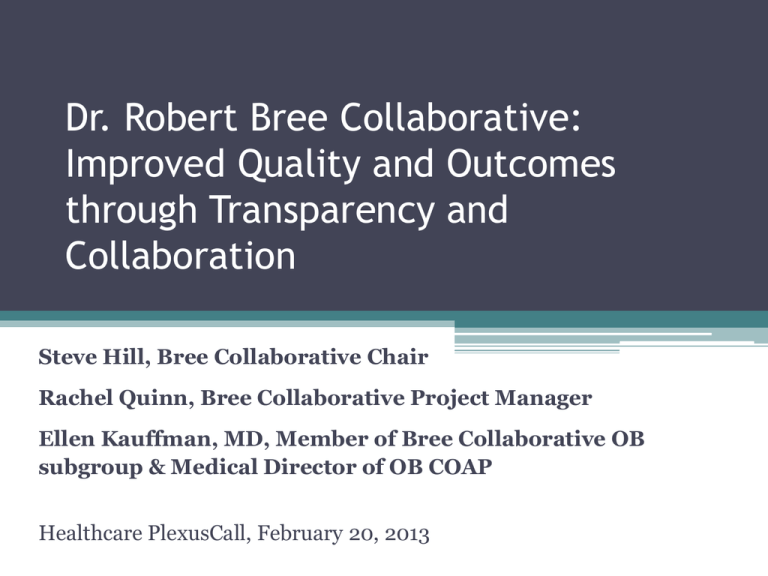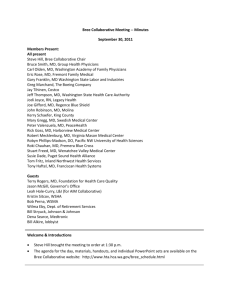Dr. Robert Bree Collaborative: Improved Quality
advertisement

Dr. Robert Bree Collaborative: Improved Quality and Outcomes through Transparency and Collaboration Steve Hill, Bree Collaborative Chair Rachel Quinn, Bree Collaborative Project Manager Ellen Kauffman, MD, Member of Bree Collaborative OB subgroup & Medical Director of OB COAP Healthcare PlexusCall, February 20, 2013 2 Dr. Robert Bree Collaborative - Background • Created by Washington State Legislature in 2011. • A public/private consortium of health care stakeholders - public and private health care purchasers, health carriers, and providers - working collaboratively to: ▫ Identify topics/services where there’s “waste” or “overuse” ▫ Recommend best practices based on data and evidence (if available) to Washington State to improve the quality, outcomes, transparency, and costeffectiveness of health care 3 Dr. Robert Bree Collaborative - Mandate Annually, must select three health care services/topics with: • • • • • • Unwarranted variation High utilization and/or cost growth trends A source of waste and inefficiency in care delivery Patient safety issues Inappropriate care Proven means/strategies to address this topic (leverage other opportunities) 4 Dr. Robert Bree Collaborative - Mandate For each selected health care topic, the Bree Collaborative must: • Identify evidence-based best practice approaches using data • Recommend quality improvement strategies ▫ Examples: Data collection, Patient Decision Aids, Centers of Excellence, Provider feedback reports 5 “Hook” of Bree Recommendations • Washington State HCA administrator must review Collaborative recommendations and decide to adopt and apply them to state purchased health care programs, e.g., Medicaid, WA State Employee Health Care Plan, Labor & Industries, Corrections • Intent is other public and private stakeholders will follow 6 Bree Year 1 Topics • Obstetrics • Cardiology • Avoidable Readmissions ▫ Total Knee Replacement and Total Hip Replacement Bundle Payments • Acute and Chronic Spine Care/Low Back Pain 7 Obstetrics Care (OB) • 1st topic selected • High unwarranted variation • High volume and cost, and patient safety issue • High priority for employers, especially Medicaid • Approximately 85,000 births in WA State Medicaid pays for half • An opportunity to “scale up” great work done to date but with employers and health plans at the table 8 OB Report • OB subgroup created in December 2011 ▫ 4 clinical experts plus employer, health plan, quality, and hospital representatives ▫ Studied best practices, and existing local and national efforts to scale up strategies statewide • 3 Focus Areas & Goals ▫ Eliminate elective deliveries before the 39th week, without a medical indication ▫ Decrease elective inductions of labor between 39 and up to 41 weeks ▫ Decrease unsupported variation among WA hospitals in the primary (first time) C-section rate 9 OB Report Findings & Recommendations • Many reasons for variation: ▫ Maternal requests and provider behavior ▫ No universally accepted clinical guidelines or community standards exist for elective deliveries or elective inductions, or whether or when to perform a C-section once labor has started • 5 Areas of Quality Improvement – “everyone has a role to play” ▫ ▫ ▫ ▫ ▫ Commitment to Quality Improvement Evidence-based or tested clinical guidelines and protocols Transparency of data on selected OB procedures, by facility Patient education Realignment of financial and non-financial incentives • Final OB report adopted by the Bree Collaborative in August 2012 and adopted by WA State in October 2012 10 Case Study – Franciscan Health System Management of Early Elective Deliveries Problem: National Leapfrog data showed high elective induction rate Ingredients for Quality Improvement • Data (chart abstracted) • Leadership: Physician champion & OB leaders • Engagement of staff at all levels • Provider and patient education • System redesign – Feedback and Reporting, “Hard Stop” 11 Plexus Institute February 20, 2013 Bree Recommendations: 3 Goals Bree Collaborative – Obstetrics Care Topic Report & Recommendations August 2, 2012 12 13 Bree Recommendations: 3 Goals Bree Collaborative – Obstetrics Care Topic Report & Recommendations August 2, 2012 14 Bree Recommendations: Labor & Delivery Bree Collaborative – Obstetrics Care Topic Report & Recommendations August 2, 2012 ARMUS 15 Bree Recommendations: Labor & Delivery Bree Collaborative – Obstetrics Care Topic Report & Recommendations August 2, 2012 ARMUS 16 OB COAP Aggregate Bree Recommendation #4: Admit Spontaneously Laboring Term Patients with Cervix on Admission >=4 Q1 - Q2 2012 47% 0% 10% 20% 53% 30% 40% Patients Admitted w/Cervix on Adm <=3 50% 60% 70% 80% 90% Patients Admitted w/Cervix on Adm >=4 Spontaneously Laboring Term Patients Admitted at >=4 cm): n= 1723 N = (cervix on admission) D = (labor type=sponteanous) + (woa >=37) + (parity CS=0) 100% 17 OB COAP Aggregate Bree Recommendation #4: Admit Spontaneously Laboring Term Patients with Cervix on Admission >=4 Q1 - Q2 2012 Cesarean cx on adm <=3 23% cx on adm >=4 10% Oxytocin 55% cx on adm <=3 cx on adm >=4 21% Regional Anesthesia 77% cx on adm <=3 56% Length of Time Admission to Delivery <=12 Hours 73% 94% Spontaneously Laboring Term Patients Admitted at >=4 cm): n=1681 N = (CS=yes) or (oxytocin=yes) or (reg anesth=yes) or (LOTAD) D = (labor type=sponteanous) + (woa >=37) + (parity CS=0) + (cx on adm) cx on adm <=3 18 Questions? Comments? Robert Bree Collaborative ▫ http://www.hta.hca.wa.gov/bree.html OB COAP ▫ www.qualityhealth.org • Steve Hill ▫ Steven.r.hill@comcast.net • Rachel Quinn ▫ rquinn@qualityhealth.org • Ellen Kauffman, M.D. ▫ ekauffman@qualityhealth.org









